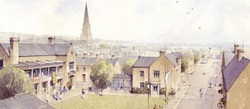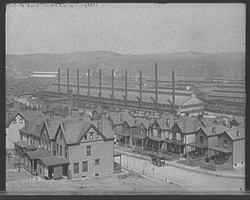
An English Mill Town.
Source: princes-foundation.org
Source: princes-foundation.org

An American Mill Town.
Source: levinemuseumofthenewsouth.blogspot.com
Source: levinemuseumofthenewsouth.blogspot.com
I. Activating Prior Knowledge
Charles Dickens was a writer during the Industrial Revolution. As a young man, Dickens was forced to leave school and take a job in a factory when his father was thrown into debtor’s prison. Many of his works served as social commentary on the state of England and English laws during this period of time.
His characters and their stories reflected the struggle between the wealthy and the industrial poor striving to make a living in the harsh, unforgiving conditions.
Whether it was a miserly business man who comes to see the error of his ways
(A Christmas Carol), a young boy living a miserable existence forced into a life of crime (Oliver Twist), or a young man forced by an abusive step-father to work in a factory (David Copperfield), we see the impact that a significant and rapid change from an agricultural existence to an industrial existence had on the people of the era.
While the writings are fictitious, their narrative about the state of man at this critical juncture speaks of frightening truths and harsh realities with the
added element of satire and humor to make the living bearable.
II. Setting A Purpose for Reading
Coketown cannot be found on a map and only existed in the imagination of Charles Dickens. However, the images of life in industrialized England create a collage that becomes Coketown. As you read the excerpt from Dickens’ Hard Times, look carefully at how he describes the features of Coketown. Create a mental picture of what you think Coketown would look like and ask yourself, “Would I like to go there? Would I like to live there?”
III. Reading the Text (Read, Re-read, and Read Again)
HARD TIMES
Charles Dickens
Excerpt Describing Coketown, from
Chapter 5: THE KEY-NOTE
... Let us strike the key-note, Coketown, before pursuing our tune.
It was a town of red brick, or of brick that would have been red if the smoke and ashes had allowed it; but as matters stood, it was a town of unnatural red and black like the painted face of a savage. It was a town of machinery and tall chimneys, out of which interminable serpents of smoke trailed themselves for ever and ever, and never got uncoiled. It had a black canal in it, and a river that ran purple with ill-smelling dye, and vast piles of building full of windows where there was a rattling and a trembling all day long, and where the piston of the steam-engine worked monotonously up and down, like the head of an elephant in a state of melancholy madness.
Stop! Can you answer these questions? If not, go back and re-read the passage.
From the reading, give an example of imagery (use of words to produce mental
images of specific sensory experiences.)
It contained several large streets all very like one another, and many small streets still more like one another, inhabited by people equally like one another, who all went in and out at the same hours, with the same sound upon the same pavements, to do the same work, and to whom every day was the same as yesterday and to-morrow, and every year the counterpart of the last and the
next.
Stop! Can you answer these questions? If not, go back and re-read the passage.
How would you describe Dickens’ opinion of Coketown based on the tone
of the passage?
These attributes of Coketown were in the main inseparable from the work by which it was sustained; against them were to be set off, comforts of life which found their way all over the world, and elegancies of life which made, we will not ask how much of the fine lady, who could scarcely bear to hear the place mentioned. The rest of its features were voluntary, and they were these.
Stop! Can you answer these questions? If not, go back and re-read the passage. In your opinion, did the wealthy elite live in Coketown?
You saw nothing in Coketown but what was severely workful. If the members of a religious persuasion built a chapel there - as the members of eighteen religious persuasions had done - they made it a pious warehouse of red brick, with sometimes (but this is only in highly ornamental examples) a bell in a birdcage on the top of it. The solitary exception was the New Church; a stuccoed edifice with a square steeple over the door, terminating in four short pinnacles like florid wooden legs.
Stop! Can you answer these questions? If not, go back and re-read the passage. What did Dickens mean when he wrote, “You saw nothing in Coketown but what was severely workful.”
All the public inscriptions in the town were painted alike, in severe characters of black and white. The jail might have been the infirmary, the infirmary might have been the jail, the town-hall might have been either, or both, or anything else, for anything that appeared to the contrary in the graces of their construction. Fact, fact, fact, everywhere in the material aspect of the town; fact, fact, fact, everywhere in the immaterial. The M'Choakumchild school was all fact, and the school of design was all fact, and the relations between master and man were ll fact, and everything was fact between the lying-in (birth) hospital and the cemetery (death), and what you couldn't state in figures, or show to be purchaseable in the cheapest market and saleable in the dearest, was not, and never should be, world without end, Amen
Stop! Can you answer these questions? If not, go back and re-read the passage. How would you describe the mood Dickens was trying to create in this excerpt?
Source: http://www.uncp.edu/home/rwb/coketown.html
IV. Personal Reflection - Respond to the following questions in your blog. Be sure to include quotes from the text to support your response.
Part 1 Response – Based on your reading of this passage, how would you describe life in Dickens’ Coketown? Since this piece was in part a social commentary on life in England during the Industrial Revolution, what can conclusions can you draw about what a real-life experience might be like in an English mill town?
Part 2 Response – You have been given to images of life in a mill town. Compare and contrast the English mill town with an American mill town. What generalization(s) can you draw about life in a mill town based on Dickens’ writing and the images?
V. Peer Reflection – Read one classmates’ reflections and respond to what they have written. You may choose to agree or disagree with their response. However, you must give sufficient and supported reasons for your opinion.
 RSS Feed
RSS Feed